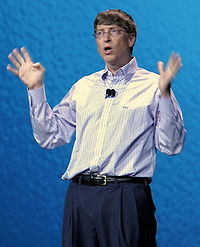- Business casual
-
For the albums, see Business Casual (Beep Beep album) and Business Casual (Chromeo album).
- Formal wear
- Formal
- Semi-formal
- Informal
- Smart casual
- Business casual
- Casual
- Active attire
Business casual is a popular dress code in professional and white-collar workplaces in Western countries. In the United States, 43% of non-self-employed workers commonly wear casual business attire. Casual street wear is the next most common work attire (28%), closely followed by uniforms (19%). Only a minority (9%) of workers wear formal business attire.[1]
Business casual has partially supplanted business formal attire wear (suits and neckties, sometimes called international standard business attire), which was previously the standard apparel for managers and professionals.
Jeans are sometimes acceptable in workplaces as part of business casual attire. Some Silicon Valley entrepreneurs such as Steve Jobs were known to wear jeans as part of the business casual look, while in other companies blue jeans are not considered suitable for managers or even business casual. [2] In academic, research and office settings, however, jeans may be worn with a polo shirt or dress shirt. The second-from-the-top button may also be opened in addition to the very top button.[citation needed] The most notable exception to this is the banking world, in which formal dress is often required.
Neckties and cufflinks are generally not required for business casual dress. Of the 33% of men who wear a necktie to work, 60% wear a necktie occasionally, while only 18% wear them all the time.[1]
Business casual is sometimes equated with (or depending on perception, confused with) smart casual.
Definitions
 Bill Gates in business-casual attire.
Bill Gates in business-casual attire.
Compared to the dress code of many blue-collar and service workers, business casual dress is not a uniform. In contrast to business informal, there is no generally accepted definition of business casual wear. The interpretation of business casual differs widely among organizations and is often a cause of confusion.[3]
The New York Times cites job search engine Monster.com's definition:
"In general, business casual means dressing professionally, looking relaxed, yet neat and pulled together." [4]
An employment counseling office at an American university defines business casual dress as a middle ground between business formal wear and casual wear.[5] The following are examples of appropriate workplace apparel from some organizations with a business-casual dress code:[citation needed]
- For women: A reasonable length skirt or trousers of a non-jeans material combined with a top (such as a dress shirt, polo, or sweater set) is considered acceptable. An informal dress with appropriate skirt length is also acceptable.
- For men: A combination of collared shirt (such as a dress shirt or polo shirt), cotton trousers (such as khakis or blue, green, brown, or black trousers) with a belt, jeans and modest shoes (such as loafers) with socks is generally acceptable. A blazer or business jacket can optionally be added.
- Unacceptable for either gender: rumpled or ripped clothing, miniskirts, underwear as outerwear, inappropriately revealing attire such as bare midriffs, and flip-flops.[4] Many corporations also frown upon open-toed shoes and shorts.
References
- ^ a b Gallup.com: "Business Casual" Most Common Work Attire
- ^ Wear the Exact Outfit of Steve Jobs for $458
- ^ USAToday.com: 'Business casual' causes confusion
- ^ a b New York Times: Redefining Business Casual
- ^ Brown, University; Career Development Center, Employer Information Sessions, http://careerdevelopment.brown.edu/services/info_sessions, retrieved 2009-08-07
External links
Categories:- 1990s fashion
- Fashion aesthetics
- Workwear
- Formal wear
Wikimedia Foundation. 2010.
